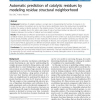Free Online Productivity Tools
i2Speak
i2Symbol
i2OCR
iTex2Img
iWeb2Print
iWeb2Shot
i2Type
iPdf2Split
iPdf2Merge
i2Bopomofo
i2Arabic
i2Style
i2Image
i2PDF
iLatex2Rtf
Sci2ools
BMCBI
2010
2010
Automatic prediction of catalytic residues by modeling residue structural neighborhood
Background: Prediction of catalytic residues is a major step in characterizing the function of enzymes. In its simpler formulation, the problem can be cast into a binary classification task at the residue level, by predicting whether the residue is directly involved in the catalytic process. The task is quite hard also when structural information is available, due to the rather wide range of roles a functional residue can play and to the large imbalance between the number of catalytic and non-catalytic residues. Results: We developed an effective representation of structural information by modeling spherical regions around candidate residues, and extracting statistics on the properties of their content such as physico-chemical properties, atomic density, flexibility, presence of water molecules. We trained an SVM classifier combining our features with sequence-based information and previously developed 3D features, and compared its performance with the most recent state-of-the-art app...
Related Content
| Added | 08 Dec 2010 |
| Updated | 08 Dec 2010 |
| Type | Journal |
| Year | 2010 |
| Where | BMCBI |
| Authors | Elisa Cilia, Andrea Passerini |
Comments (0)

